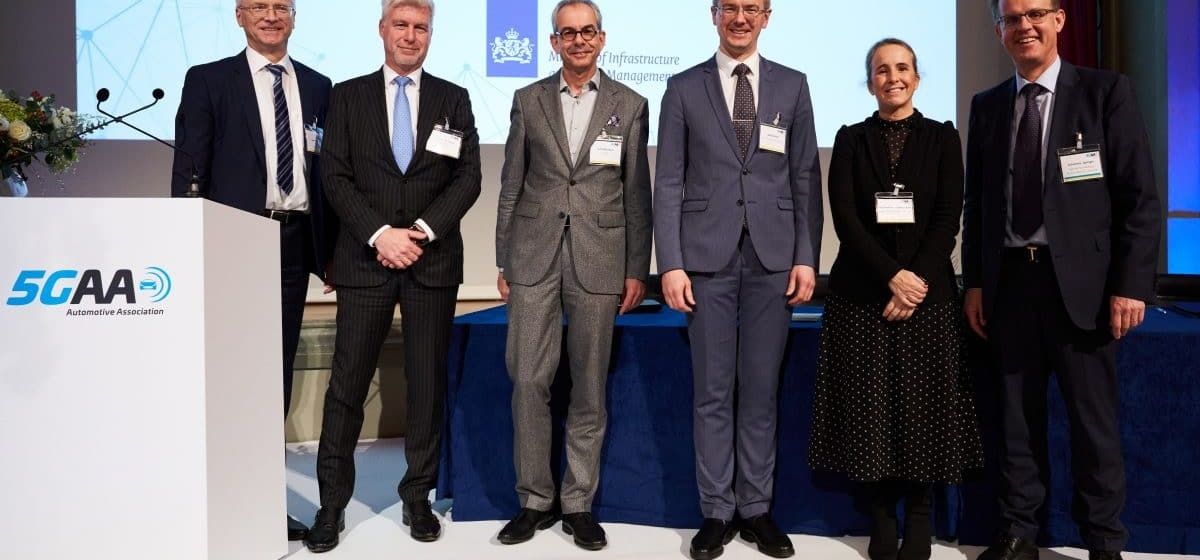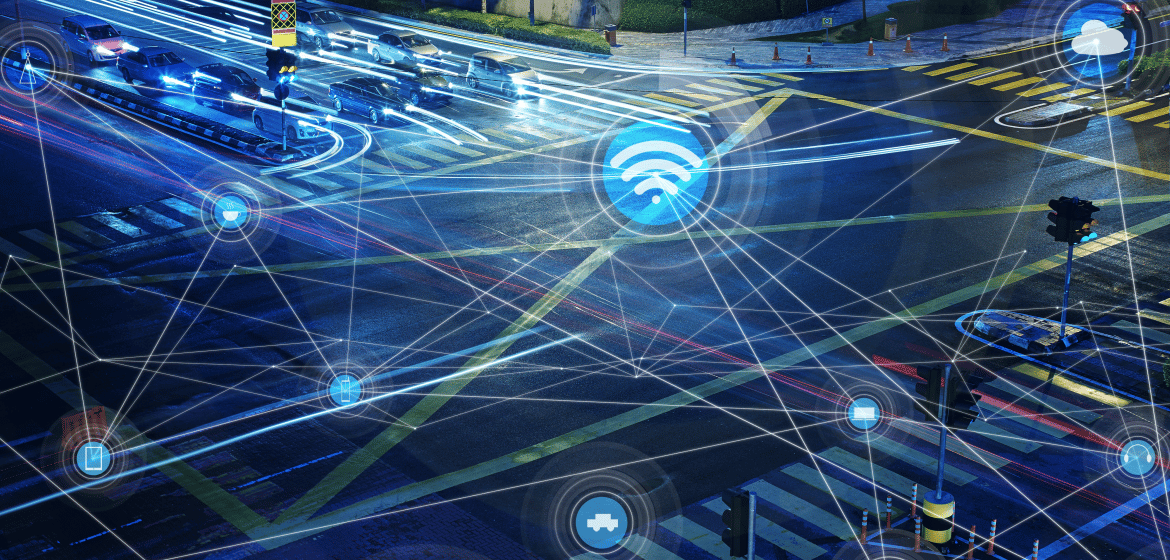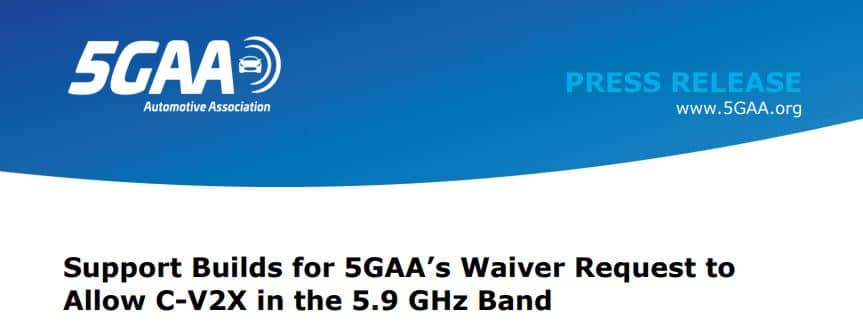
Press Release: Public and Private Sectors Aligned Behind V2X Deployment, 2023 a Pivotal Year
Brussels – Today, we join together to reaffirm our continued support for the rapid, widespread deployment of vehicle-to-everything (V2X) technologies in order to further improve safety on American roads. V2X, which allows communication between vehicles, infrastructure, and other road users such as pedestrians and bicyclists, provides drivers with crucial warnings necessary to improve safety. Our organizations represent the full breadth of the transportation stakeholder community and are aligned in our belief that the widespread deployment of V2X technologies can dramatically reduce crashes and fatalities on American roads for all road users.
We believe that 2023 will be a pivotal year for V2X deployment. Transportation stakeholders have aligned behind one V2X technology, cellular vehicle-to-everything (C-V2X), clearing the way for a unified, nationwide approach to the deployment of this tool. The U.S. Department of Transportation (USDOT) recently held a V2X Summit in which it committed to the development of a Nationwide V2X Deployment Plan, lending crucial leadership to the deployment of these technologies. The Federal Communications Commission (FCC) is poised to deliver much needed regulatory clarity for the deployment of C-V2X through the issuance of pending waivers to operate in the 5.9 GHz Band. Multiple stakeholders are making significant investments in CV2X today, and the waivers under consideration at the FCC are urgently needed to move forward with deployment plans.
We wish to express our appreciation for the work being done by USDOT, FCC, and the National Telecommunications and Information Administration to maintain interference-free dedicated spectrum and quickly establish the regulatory framework that will allow for widespread deployment of C-V2X. This includes the FCC first allowing near-term deployments to move forward under waiver authority, the FCC issuing a Second Report and Order that sets the final rules for the future of these technologies and protects the spectrum from interference, and USDOT adopting a Nationwide V2X Deployment Plan. As these steps are undertaken, our organizations will continue to work collaboratively to resolve remaining issues to deploy CV2X, giving drivers and other road users a critical tool to improve safety, reduce crashes, and decrease fatalities.
Intelligent Transportation Society of America
American Association of State Highway and Transportation Officials
Alliance for Automotive Innovation
American Highway Users Alliance
American Traffic Safety Services Association
American Trucking Association
Institute of Transportation Engineers
5G Americas
5G Automotive Association
National Electrical Manufacturers Association
About 5GAA
The 5G Automotive Association (5GAA) is a global, cross-industry organization of over 130 members made of leading global automakers, Tier-1 suppliers, mobile operators, semiconductor companies, and test equipment vendors. It works together to develop end-to-end solutions for future mobility and transport services. 5GAA is committed to helping define and develop the next generation of connected mobility, automated vehicle, and intelligent transport solutions based on C-V2X.

Federal Funding Opportunity for Wireless Technology: Safe Streets and Roads for All (SS4A) Grant Program
Through September 15, 2022, a Notice of Funding Opportunity (NOFO) from the U.S. Department of Transportation (USDOT) will be open for Safe Streets and Roads for All (SS4A) grants in FY22. It’s an opportunity for companies to apply for a part of $1 billion per year in FY22-26 grants to prevent roadway deaths and serious injuries.
The timing is fortuitous. Newly released traffic crash estimates from the National Highway Traffic Safety Administration (NHTSA) show that traffic fatality rates in 2021 are the highest since 2005. NHTSA projects a final tally of 42,915 lives lost during 2021 in traffic crashes nationwide.
Making transportation safer and more equitable
To support its goals, the SS4A program funds activities that will help lower fatalities on U.S. roads and highways. The program is also an opportunity to fund regional, local and Tribal initiatives aimed at making transportation equitable for all road users.
Equity is an important element in underserved communities, which are disproportionately affected by fatalities among vulnerable road users (VRUs). These users include pedestrians, cyclists and the growing number people using micro-mobility options such as e-bikes and scooters.
Underserved communities also have higher vehicular traffic volumes, trucking routes and major arterial roads. They are characterized by intersections that are unsafe or impassable by foot or bike, and an overall lower level and quality of walking and cycling infrastructure. NHTSA’s projections for 2021 show alarming increases in fatalities for pedestrians (13 percent), motorcyclists (9 percent) and bicyclists (5 percent), making the SS4A funding opportunity even more fortuitous for VRUs.
Applying C-V2X technology to prevent road fatalities
Many roadway deaths are preventable. Cellular-vehicle-to-everything (C-V2X) is a wireless technology that allows vehicles to communicate directly with each other (V2V), with roadside infrastructure (V2I) and potentially with pedestrians (V2P). C-V2X supports information sharing to facilitate applications that enhance safety for all road users.
NHTSA believes that safety applications supported by V2V and V2I could eliminate or mitigate the severity of up to 80 percent of non-impaired crashes. Also, connected vehicle technology is on the National Transportation Safety Board’s Most Wanted List of transportation safety improvements.
The following use cases illustrate the immediate impact of safety applications that use C-V2X technology:
- Red-light violation warning (RLVW)
More than half of all fatal and injury crashes happen at intersections (source). The most common cause of all urban crashes, drivers running red lights result in an average of seven fatalities and more than 1,000 injuries per day at signalized intersections across the country (source).

- Intersection movement assist (IMA)
Similar to RLVW, IMA safety applications can alert other drivers when someone is running a red light so they can take action to stop before entering the intersection. - Spot weather warnings
Inclement weather, which can result in road hazards such as icy patches on highways, are not easily detected by LIDAR sensors. Infrastructure-to-vehicle (I2V) applications can send a warning to approaching vehicles, reducing the potential for sharp drops in speed that can result in road incidents. - Traffic signal pre-emption
Aimed at shortening emergency response times to help save lives, this use case allows vehicles like ambulances and fire trucks to remotely trigger a green light. Related V2V applications share this information with nearby vehicles so drivers can take action to move out of the way, reducing congestion along the route to improve safety for first responders and road users alike. - School zone safety
C-V2X alerts drivers when they are entering an active school zone and notifies them of the reduced speed limit. Future applications might include automatically slowing vehicles as they approach an active school zone.
See more use cases below.
What you can’t see can hurt you, and C-V2X plays a critical safety role because it allows the vehicle to see more than the driver can see. Regular sensors keep vehicles safe in immediate surroundings; C-V2X provides more robust signaling to help vehicles see around blind corners and many other types of obstructions. It connects vehicles and roadside infrastructure that are not in each other’s line of sight and allows them to share information about traffic conditions.
How C-V2X fits with SS4A
SS4A accepts both Action Plan Grants and Implementation Grants, with the latter drawing upon the foundation of the former. The program calls out four selection criteria:
- Safety impact
- Equity, engagement, collaboration
- Effective practices and strategies
- Climate and sustainability, and economic competitiveness
Two notable considerations are project readiness and funds to underserved communities.
USDOT lists several sample activities for Implementation Grants that align closely with C-V2X, including these:
- Deploying advanced transportation technologies, such as the installation of connected intersection-based safety solutions and vehicle-to-infrastructure advisory speed limit systems (e.g., intelligent speed assistance — see above)
- Evaluating and improving the safety of intersections by considering innovative design changes, improved delineation, and advanced warning
- Creating safe routes to school and public transit services through multiple activities that lead to people safely walking and biking in underserved communities.
- Promoting the adoption of innovative technologies or strategies for the safety and protection of VRUs in high-traffic areas where commercial motor vehicles (CMVs), pedestrians, bicyclists, and motorcyclists interact.
Next steps
As part of the Bipartisan Infrastructure Law, SS4A is a discretionary program with $5 billion in appropriated funds over the next 5 years. A related opportunity opening up in late 2022 is the $500 million Strengthening Mobility and Revolutionizing Transportation (SMART) Grants from USDOT. Both SS4A and SMART provide a path to federal funding to build novel uses of C-V2X and 5G technologies into the nation’s infrastructure. To provide more visibility for industry stakeholders, USDOT has published a full list of funding opportunities with anticipated dates for 2022.
Applications built around C-V2X can help make intersections safer and reduce fatalities due to speeding in the use cases shown above, as well as in these:
- At-grade rail crossings — alerting emergency vehicles that a rail crossing is closed, enabling early rerouting and avoiding delays in life-saving calls
- Pedestrian crossings — detecting when a VRU is in the crosswalk ahead and warning approaching drivers to proceed with caution
- Incident clearance and response — sending alerts to drivers as they approach an emergency vehicle stopped in or along the roadway ahead, thereby helping to prevent secondary crashes
- Wrong-way driving — detecting drivers who go the wrong way on on-ramps and highways, then alerting the driver, nearby drivers, and law enforcement
These applications can also help make transportation equitable in underserved communities, fulfilling another important goal of SS4A.
Find out how to apply for SS4A grants here and in the USDOT’s “Safe Streets and Roads for All” webinar series.

5GAA partnered with ETSI and DEKRA to showcase C-V2X Interoperability and discuss deployment during the plugtests at the DEKRA Automobil Test Center in Klettwitz, Germany
5GAA partnered with ETSI and DEKRA to showcase C-V2X Interoperability and discuss deployment during the plugtests at the DEKRA Automobil Test Center in Klettwitz, Germany
April 1st, 2022 (Klettwitz, Germany) The 5G Automotive Association (5GAA) proudly partnered again with ETSI for their third C-V2X Plugtests™ event hosted by DEKRA at its Automobil Test Center in Klettwitz, Germany, from March 28th to April 1st. The testing activities resulted in high levels of interoperability and allowed to validate the understanding of the standards. 5GAA organised a series of demonstrations to showcase these successes following its workshop on “C-V2X Interoperability and Deployment” on March 31st.
5GAA has proudly partnered again with the European Telecommunications Standard Institute (ETSI) for the third ETSI C-V2X Plugtests™. The tests took place from March 28th to April 1st event at the Klettwitz (Germany) Automobil Test Center of the 5GAA Member DEKRA. The activities enabled On-Board-Units (OBUs), Roadside-Units (RSUs) and public key infrastructure (PKIs) vendors to run interoperability test sessions to assess the level of interoperability of their implementation and validate the understanding of the standards. The testing activities have been concluded with a high success rate for the preliminary tests, showing an extremely positive level of multi-vendor interoperability.
In addition, on March 31st, 5GAA organised a workshop on “C-V2X Interoperability and Deployment”, gathering key players of the C-V2X ecosystem, including governmental entities and companies, to discuss the future of C-V2X for the automotive industries and the role of certification for the deployment of the technology, concluding with an insightful panel discussion. The Federal Highway Research Institute (BASt) provided great insights on collaboration amongst the key stakeholders (policy-makers, industries, research institutes, etc.) and the 2050 CCAM Roadmap. The leading organisation for product testing and certification, DEKRA, shed light on the impact of certification for the 5G Automotive as well as how it is developed. T-Systems gave an overview on how 5G Mobile edge computing enables various C-ITS Services, and Vodafone presented its – recently announced – Safer Transport for Europe Platform (STEP).
“The long-standing collaboration between the 5G Automotive Association, ETSI and DEKRA is extremely valuable for our association and our work to accelerate C-V2X deployment,” concluded Maxime Flament, 5GAA CTO, “the technology is constantly evolving, and events like this are the greatest opportunity to strengthen ecosystem cooperation, stimulate global implementation and commercial availability.”
Interoperability Demonstrations
Following the workshop, the attendees were invited to join Vodafone, Commsignia, CTAG and Allbesmart on DEKRA’s outside testing area to witness various interoperability demonstrations. You can find short descriptions of the demonstrations below:
- Vodafone worked with Commsignia to demonstrate the interoperability between the Vodafone Safer Transport for Europe Platform (STEP) and three different Android OS and Apple iOS applications, and three different MNO SIMs.
- APP1 developed in house (Vodafone Demo, used for technical internal testing and showcase)
- APP2 was developed in house in conjunction with a 3rd party (Vodafone Driving Academy)
- APP3 was developed by a 3rd party (Eloy Drive)
- CTAG showcased the generation of the events for their Road-Side Unit (RSU) and the reception in the On-Board Unit (OBU). The events have been shown on a tablet running an Android App and performed use cases on Road Works Warning, Time To Green, In-Vehicle Signage, Traffic Jams Warning and Hazard On The Road Warning.
- Allbesmart demonstrated its C-ITS platform integrated into a Cohda Wireless MK6c RSU, being able to issue events with minimal configuration and check on the health status of the Road-side Unit. An on-board application on a tablet allowed to visualise the messages with regard to the use cases on Road Works Warning, Traffic Jams Warning and Hazard On The Road Warning.
- Commsignia, the company developing C-ITS solutions for automotive and smart city, partnered up with Allbesmart to demonstrate the use cases On Intersection Collision Risk Warning and Longitudinal Collision Risk Warning. For the demo, they used Commisignia’s C-V2X OBU interoperating with Cohda C-V2X OBU provided by Allbesmart.
You can download the Workshop’s presentations here:
Part 1; Part 2 ;Part 3; Part 4


5GAA partners with ETSI for the third ETSI C-V2X Plugtests™ event hosted by DEKRA at its Automobil Test Center in Klettwitz, Germany
The 5G Automotive Association (5GAA) is proud to partner again with the European Telecommunications Standard Institute (ETSI) and for the third ETSI C-V2X Plugtests™ event hosted by DEKRA at its Automobil Test Center in Klettwitz, Germany.
From 28 March to 1 April 2022, ETSI and DEKRA will enable On-Board-Unites (OBUs), Roadside-Units (RSUs) and public key infrastructure (PKIs) vendors to run interoperability test sessions to assess the level of interoperability of their implementation and validate the understanding of the standards.
Additionally, 5GAA organises a workshop on “C-V2X Interoperability and Deployment” to bring together some key players in the C-V2X deployment and interoperability ecosystem. The workshop will take place on Thursday 31 March, from 09:00 to 12:30 CEST at the Dekra Testing Site. The discussion will focus on the future of C-V2X for the automotive industries and the role of certification for the deployment of the technology.
Participants will also have the great opportunity to join live interoperability demonstration on DEKRA’s outside testing area and discover ETSI’s ITS Test Scenarios use cases showcased by various companies.
Interested in attending the C-V2X PlugtestsTM event? Registrations are open until 21 March. Due to the Covid restrictions, capacity on-site is limited.
For any further information, please contact marcom@5GAA.org
5GAA WORKSHOP AGENDA
Please see the full agenda here:
9:00 – 09:30 – Opening session
Welcome to DEKRA Automotive Test Center Klettwitz
Thomas Jaeger, Head of Technology Technical Service Management, Senior Vice-President, Service Division Product Testing, DEKRA
Welcome to Plugtests Event
Ultan Mulligan, Director, ETSI Centre for Testing and Interoperability (CTI)
5GAA welcome and introduction to the workshop
Maxime Flament, Chief Technology Officer, 5G Automotive Association
09:30 – 09:50 – Session 1
Debrief of Klettwitz plugtests activities
Saurav Arora, Technical Project Manager, PlugtestsTM Event
10:20 – 11:35 – Session 2
Road operator perspective: “German Perspective on C-ITS Deployment”
Farzin Godarzi, Scientific Officer, Federal Highway Research Institute (BASt, Bundesanstalt für Straßenwesen)
The future of C-V2X: “Commercial deployment of C-V2X vehicles”
Johannes Springer, Chief Technology Officer Connected Cars, Deutsche Telekom
Certification: “The importance of Certification for 5G Automotive”
Thomas Jaeger, Head of Technology Technical Service Management, Senior Vice-President, Service Division Product Testing, DEKRA
Testing Network V2X platform: “Vodafone’s V2X Safer Transport for Europe Platform (STEP)”
Robert Banks, Technology Development Manager, Vodafone
11:35 – 12:10 Moderated discussion – Bringing C-V2X on the Roads: the Role of Interoperability for Deployment
Moderator, Maxime Flament, Chief Technology Officer, 5G Automotive Association
12:10 – 12:30 Closing Remarks
Saurav Arora, Technical Project Manager, PlugtestsTM Event
Maxime Flament, Chief Technology Officer, 5G Automotive Association
Download the agenda here.

5G Automotive Association Statement of Support for C-V2X Joint Waiver Request
December 14, 2022 – A group of leading transportation stakeholders filed a request at the United States Federal Communications Commission (FCC) seeking immediate authority to move forward with Cellular Vehicle-to-Everything deployments. Signatories to the filing include automakers Ford, Audi, and Jaguar Land Rover, the Utah and Virginia state departments of transportation, and a number of equipment manufacturers, including 5GAA members Applied Information, Cohda Wireless, Commsignia, Danlaw, HARMAN and Panasonic.
The filing follows last year’s unanimous decision by the FCC concluding that the United States should move forward with C-V2X exclusively. In that decision, the FCC invited automakers, road operators, and equipment manufacturers to seek rule waivers if interested in deploying C-V2X in the near term. The FCC reasoned that these waivers would enable a smoother and more rapid deployment of C-V2X while the agency considered final rules for the technology.
“Today’s joint waiver request from leading automakers, state departments of transportation, and equipment manufacturers signifies the collaborative efforts underway to ensure the successful implementation of C-V2X,” stated 5GAA CTO Maxime Flament. “It also demonstrates the strong demand across the transportation industry to immediately deliver C-V2X safety services to American travelers, especially as deployments accelerate in other regions of the world. On the heels of its recent unanimous decision to move forward with C-V2X, the FCC should quickly grant this waiver request and afford stakeholders the ability to move forward with this state-of-the-art roadway safety technology.”

5GAA officialises five new MoUs during Brussels conference
Is 5G in-car technology ready for automated driving? Are Europe’s roads up to speed for this digital revolution? Are governments, road authorities and industry on the same page? What is Europe’s strategy to secure leadership and capture markets in the field? These and other pressing questions and challenges for connected and automated mobility were addressed on 6 February, at the 5GAA-hosted event – 5G, Igniting the Connected and Automated Mobility Revolution – in Brussels’ Concert Noble. High-level representatives and experts from industry, governments and the EU explored the capabilities, deployment models and vast opportunities of the latest ‘cellular vehicle to everything’ (C-V2X) technology.
BRUSSELS, 6 February 2020 – The 5G Automotive Association (5GAA) organised a conference bringing together EU representatives and the connected automotive ecosystem to the heart of Europe, to officialise its public-private partnerships with several European authorities. Indeed, 5GAA announced extending its partnership network by signing Memoranda of Understanding with the Dutch Ministry of Infrastructure and Water Management, the Italian Ministry of Technological Innovation and Digitalisation, the Spanish Directorate-General of Traffic (DGT), the German Federal Highway Research Institute (BASt) and the Electronic Communication Office of Latvia (VASES). The ambition of the association is to strengthen the collaboration between industry and the public sector and to facilitate the dialogue to drive innovation in mobility and transport with these closer collaborations.
Some recognised speakers at the conference included BMW’s Joachim Göthel, Senior Manager in the German automaker’s ‘Project 5G Alliance’, and Dino Flore who is Vice-president of Technology at Qualcomm, the US chipmaker, as well as Robert MacDougall who heads mobile operator Vodafone Enterprise’s Public Policy Unit. They were joined by senior EU policymakers, including a message from Maria Koleva on behalf of the European Commissioner for Innovation, Research, Culture, Education and Youth Mariya Gabriel and speech by Pearse O’Donohue, Director for Future Networks, Directorate-General for Communications Networks, Content and Technology, as well as national experts from the Netherlands and Spain giving their unique perspective.
“To fulfil its potential in connected and automated mobility, Europe really needs a clear policy message reinforcing its ‘technology neutral’ approach in the future C-ITS regulations,” noted 5GAA’s CTO and spokesperson Maxime Flament.
Automated and connected driving, intelligent driver assistance and data-driven transportation network optimisation are examples of what tomorrow’s transportation will look like for people and governments.
Discussions and conclusions reached at the 5G, Igniting the Connected and Automated Mobility Revolution conference thus paint a rich picture of the work currently underway and the roadblocks and potential detours that may lie ahead. With the help of audience contributions, the event helped to chart the way for future autonomous transport that not only meets the needs of society and industry but can also make a positive contribution to meeting the global Sustainable Development Goals in terms of cleaner and safer transportation.
About 5GAA
The 5G Automotive Association (5GAA) is a global, cross-industry organisation of over 130 members comprised of leading global automakers, Tier-1 suppliers, mobile operators, semiconductor companies and test equipment vendors. It works together to develop end-to-end solutions for future mobility and transport services. 5GAA is committed to helping define and develop the next generation of connected mobility, automated vehicle and intelligent transport solutions based on C-V2X.
Learn more on the 5GAA website and follow us on Twitter and LinkedIn.
Media Contacts
Delia Voica
Tel.: +32 486 69 76 22
Email: delia.voica@5gaa.org
Marketing and Communications Team
Email: marcom@5gaa.org

5GAA Statement on FCC Chairman’s Proposal for the 5.9 GHz Band
In response to Federal Communications Commission Chairman Ajit Pai’s proposal for the 5.9 GHz band, the 5G Automotive Association issues the following statement:
The 5G Automotive Association applauds Chairman Ajit Pai for proposing to dedicate a portion of the automotive safety spectrum for the use of Cellular Vehicle-to-Everything (C-V2X). Extensive crash avoidance testing continues to demonstrate that C-V2X technology will deliver safety benefits to the American public. We look forward to working with all stakeholders throughout this process to ensure that spectrum regulations adequately address the needs of transportation safety.
You can find the official FCC chairman speech here.

5GAA publishes test results in support to C-V2X FCC petition for waiver
Recently, the 5G Automotive Association (5GAA) filed a petition for waiver with the Federal Communications Commission of the United States requesting that C-V2X be allowed to operate in the upper 20 MHz (5905 MHz – 5925 MHz) of the US ITS band.
In support of this petition, 5GAA member companies have performed a series of tests in an attempt to address anticipated technical questions related to the favourable implementation of this petition. The report describes the test procedures and results that were undertaken to support the 5GAA C-V2X FCC petition for waiver in the 5.9 GHz band.
The report presents results of testing C-V2X in 20-MHz wide CH183 – the channel that has been recently proposed for C-V2X deployment in the ITS band and is referred to as basic C-V2X Channel and it allows for V2V and V2X messages such as basic safety message (BSM), signal phase and timing (SPaT), signal request message (SRM), signal status message (SSM), and others covered by the Road Safety Message under development in SAE standards. The upper part of the ITS band was chosen to minimize impact to DSRC channels, especially CH172.
The viability of C-V2X in 10 MHz has been demonstrated in a preceding report in which C-V2X has been shown to outperform DSRC in terms of reliability, resilience to out-of-band interference and range. This report extends these results by showing that a BSM message sent in 20‑MHz CH183 has the same reliability as previously shown in 10-MHz CH184.
Both lab and field data included in the report demonstrate consistent results:
- C-V2X communication in 20-MHz CH183 has the same reliability performance (Packet Reception Ratio vs. distance) as the identical BSM-like message transmission in 10-MHz CH184.
- Impact of C-V2X high load transmissions in CH183 on DSRC basic safety transmissions in CH172 is negligible up to a 1.4-km range in LOS conditions
- Impact of C-V2X high load transmissions in CH183 on V2I and I2V transmissions in CH178 is negligible up to a 1.4‑km range in LOS conditions
- Impact of C-V2X high load transmissions in CH183 on V2I and I2V transmissions in CH180 is negligible up to 1 km in LOS Conditions
Read the full report here.

5GAA presents 5.9 GHz Band Plan to the FCC that will enable evolution of C-V2X from LTE to 5G
The 5G Automotive Association (5GAA) has recently filed a letter to the Federal Communications Commission (FCC) presenting the content of its band plan for the 5.9 GHz band.
The filing, which was submitted last 3rd April, positions C-V2X as the best opportunity to further the vision of ITS in the 5.9 GHz band, outlining that the FCC should pursue a forward-looking approach for licensed ITS operations in the 5.9 GHz band towards facilitating the evolution path towards 5G.
Moreover, the filing also follows-up on 5GAA’s waiver request, filed with the objective of enabling initial deployments of this potentially life-saving technology as soon as possible.
Just on February major stakeholders from the automobile, wireless, and technology industries filed comments to the FCC in support of the 5G Automotive Association’s waiver request seeking permission to deploy Cellular Vehicle-to-Everything (C-V2X) technology in a portion of the 5.9 GHz band.

US Support Builds for 5GAA’s Waiver Request to Allow C-V2X in the 5.9 GHz Band
Stakeholders from the automobile, wireless, and technology industries filed comments at the US Federal Communications Commission (FCC) in support of the 5G Automotive Association’s waiver request seeking permission to deploy Cellular Vehicle-to-Everything (C-V2X) technology in a portion of the 5.9 GHz band.
Click here to have a look at the official press release.


